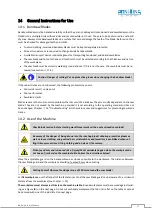
BA_PH_3V_EN_07-22.docx
43
Danger of cutting if the workpiece is tilted! The saw blade can tear and cause cutting injuries.
Large and long workpieces
For large or long workpieces, an appropriate table extension
must be used, see Figure
(
A
).
For cuts without push stick, ensure a safe distance (> 10 cm) of
the hands from the saw blade.
Round and cylindrical workpieces
For round and cylindrical workpieces, slipping or rolling away of
the workpieces must be prevented. These are to be secured
with a handle, wedge, bolt, prism or other comparable tools,
see
Figure (
B
).
Short pieces - cutting splinters
Always use push sticks to prevent danger to the hands, see
Figures (
C
) and (
D
).
Straight cuts
To prevent the workpiece from tilting or slipping away, always
use the fence for straight cuts (see chapter
12). It must be set
to the width of the workpiece to be cut. The workpiece must
rest on the table and be fed in a safe way. When feeding manu-
ally with the fence, use a push stick if it is necessary to feed close
to the bandsaw blade.
Diagonal cuts
On machines with a fixed table, there should be a secure work-
piece support for diagonal cutting by means of a fixture. Use a
push stick at the end of the cut.
Tenon cutting
If a tenoning machine is not available, tenons can also be cut
safely with a bandsaw.
Figure 31: Table extensions and tools
Crosscut sawing of upright standing workpieces
When crosscutting upright workpieces, e.g. when setting down tenons, a possible tilting of the workpiece must
be prevented by a stop bracket.
Cutting wedges
To cut small wedges on the bandsaw machine, the use of a fixture is required.
Curved and irregular cuts
When making curved or irregular cuts on a bandsaw, it is necessary to feed the workpiece evenly. It must be held
firmly on the table for effective guidance during cutting. The hands must be at a safe distance from the saw
blade. A template can also be used. For repeated curved or irregular cuts, a fence fixed in front of the bandsaw
blade can be used in conjunction with a template. This improves both safety and working speed.
Cross cutting of round timber
When cross-cutting logs, the workpiece must be secured against rotation by using a fixture or holding device.
Further, a bandsaw blade suitable for cross-cutting must be used.
Cutting round plates
For cutting round panels, it is recommended to use a device suitable for this purpose.
B
D
C
A












































